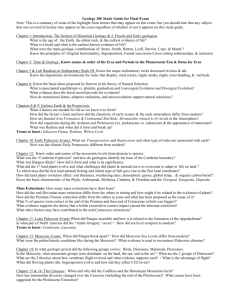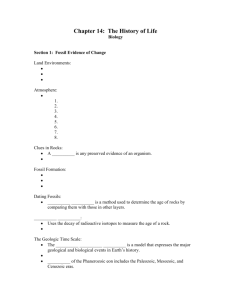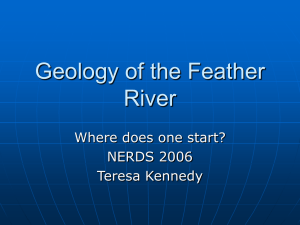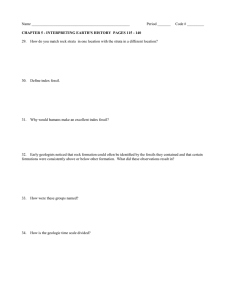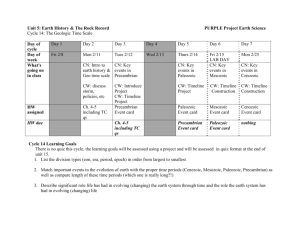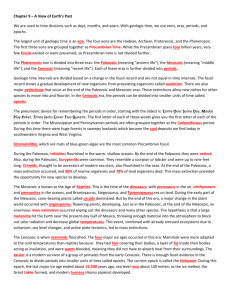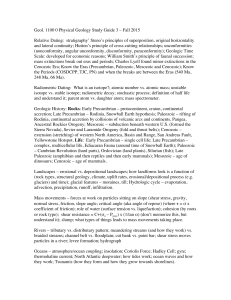HISTORICAL LECTURE TEST # 4 - 2009
advertisement
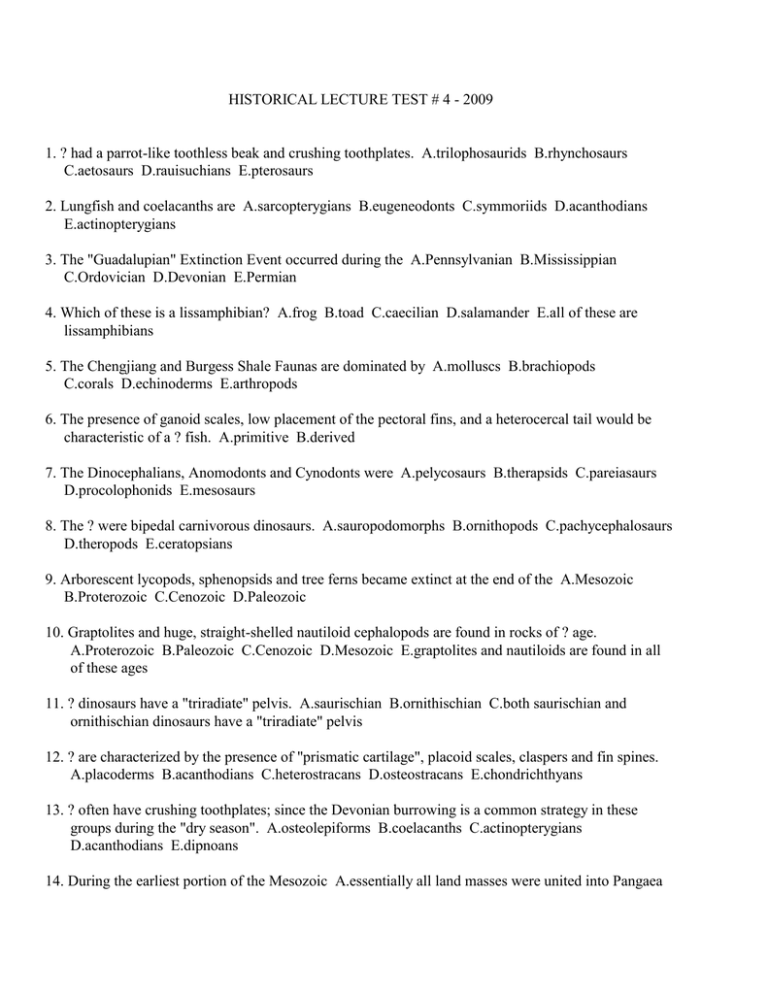
HISTORICAL LECTURE TEST # 4 - 2009 1. ? had a parrot-like toothless beak and crushing toothplates. A.trilophosaurids B.rhynchosaurs C.aetosaurs D.rauisuchians E.pterosaurs 2. Lungfish and coelacanths are A.sarcopterygians B.eugeneodonts C.symmoriids D.acanthodians E.actinopterygians 3. The "Guadalupian" Extinction Event occurred during the A.Pennsylvanian B.Mississippian C.Ordovician D.Devonian E.Permian 4. Which of these is a lissamphibian? A.frog B.toad C.caecilian D.salamander E.all of these are lissamphibians 5. The Chengjiang and Burgess Shale Faunas are dominated by A.molluscs B.brachiopods C.corals D.echinoderms E.arthropods 6. The presence of ganoid scales, low placement of the pectoral fins, and a heterocercal tail would be characteristic of a ? fish. A.primitive B.derived 7. The Dinocephalians, Anomodonts and Cynodonts were A.pelycosaurs B.therapsids C.pareiasaurs D.procolophonids E.mesosaurs 8. The ? were bipedal carnivorous dinosaurs. A.sauropodomorphs B.ornithopods C.pachycephalosaurs D.theropods E.ceratopsians 9. Arborescent lycopods, sphenopsids and tree ferns became extinct at the end of the A.Mesozoic B.Proterozoic C.Cenozoic D.Paleozoic 10. Graptolites and huge, straight-shelled nautiloid cephalopods are found in rocks of ? age. A.Proterozoic B.Paleozoic C.Cenozoic D.Mesozoic E.graptolites and nautiloids are found in all of these ages 11. ? dinosaurs have a "triradiate" pelvis. A.saurischian B.ornithischian C.both saurischian and ornithischian dinosaurs have a "triradiate" pelvis 12. ? are characterized by the presence of "prismatic cartilage", placoid scales, claspers and fin spines. A.placoderms B.acanthodians C.heterostracans D.osteostracans E.chondrichthyans 13. ? often have crushing toothplates; since the Devonian burrowing is a common strategy in these groups during the "dry season". A.osteolepiforms B.coelacanths C.actinopterygians D.acanthodians E.dipnoans 14. During the earliest portion of the Mesozoic A.essentially all land masses were united into Pangaea B.Pangaea had "broken up", and most of the modern continents had formed 15. A notochord, a dorsal hollow nerve cord and an endostyle organ are characteristic of A.molluscs B.brachiopods C.chordates D.echinoderms E.arthropods 16. ? are armor-plated reptiles that have a secondary palate; some Mesozoic types were fully marine in their habits. A.plesiosaurs B.ichthyosaurs C.crocodilians D.mosasaurs E.placodonts 17. ? gave rise to amphibians. A.osteolepiforms B.coelacanths C.actinopterygians D.acanthodians E.dipnoans 18. Ceratosaurs, carnosaurs and deinonychosaurs were A.sauropodomorphs B.ornithopods C.pachycephalosaurs D.theropods E.ceratopsians 19. The ? were the "bone-headed" dinosaurs. A.sauropodomorphs B.ornithopods C.pachycephalosaurs D.theropods E.ceratopsians 20. ? developed from dermal denticles in vertebrates. A.appendicular skeletons B.axial skeletons C.jaws D.teeth E.all of these developed from dermal denticles 21. ? dinosaurs have a predentary bone. A.saurischian B.ornithischian C.both saurischian and ornithischian dinosaurs have a predentary bone 22. The ? includes ferns and their allies. A.Rhyniophyta B.Psilopsida C.Lycophyta D.Sphenophyta E.Filicinophyta 23. Which of these is a lepidosauromorph? A.lizard B.dinosaur C.pterosaur D.plesiosaur E.all of these are lepidosaurorphs 24. The oldest dinosaurs are of ? age. A.Triassic B.Pennsylvanian C.Permian D.Jurassic E.Cretaceous 25. ? may have originated from gill arch supports, or may have been formed when a series of connector genes began to make cartilage "supports". A.axial skeletons B.appendicular skeletons C.jaws D.these features may have been important in the development of both skeletons and jaws 26. ? gave rise to mammals. A.pelycosaurs B.therapsids C.pareiasaurs D.procolophonids E.mesosaurs 27. The ? had a small skull and short front legs; there were a series of plates and spines arranged in a row down the neck, trunk and tail. A.ankylosaurs B.ornithopods C.pachycephalosaurs D.stegosaurs E.ceratopsians 28. Quetzalcoatlus, from the Big Bend region of Texas, was a huge A.theropod B.sauropodomorph C.crocodile D.bird E.pterosaur 29. The "bolide impact event" has been hypothesized for the extinction event at the end of the A.Proterozoic B.Mesozoic C.Cenozoic D.Paleozoic 30. In a ? fish tail, the upper lobe is the largest. A.heterocercal B.hypocercal C.homocercal D.diphycercal 31. Theropod dinosaurs are A.saurischians B.ornithischians C.it depends upon the type of theropod 32. The placental and marsupial mammals originated in the A.Permian B.Cretaceous C.Pennsylvanian D.Jurassic E.Triassic 33. Captorhinids, pareiasaurs and pelycosaurs were of ? age. A.Mesozoic B.Proterozoic C.Paleozoic D.Cenozoic E.these groups were found in all of these ages of Earth history 34. Snakes have extreme streptostyly. This means that snakes A.lost their legs B.loosened their skulls C.streptostyly involves both loss of limbs and loosening skull bones 35. A vertical jaw and the dominance of the premaxilla in feeding is characteristic of ? fish. A.primitive B.derived 36. Aragonite-secreting algae, fusulinid foraminiferans, and aragonite-secreting sponges were important reef-formers during the A.Early Mesozoic B.Late Mesozoic C.Early Cenozoic D.Early Paleozoic E.Late Paleozoic 37. ? have a "perforate acetabulum". A.trilophosaurids B.rhynchosaurs C.aetosaurs D.rauisuchians E.dinosaurs 38. Plesiosaurs and ichthyosaurs were A.euryapsids B.anapsids C.synapsids 39. The Morrison Formation, famous for its dinosaur deposits, is of ? age. A.Silurian B.Pennsylvanian C.Permian D.Jurassic E.Cretaceous 40. Cephalization and the development of a fusiform shape is characteristic of A.molluscs B.brachiopods C.vertebrates D.echinoderms E.arthropods 41. The Gulf of Mexico began forming during the ?; at this time great thicknesses of evaporites were precipitated, including the Louann Salt. A.Silurian B.Pennsylvanian C.Permian D.Jurassic E.Cretaceous 42. Mammals have a ? jaw articulation. A.dentary-squamosal B.quadrate-articular 43. The first great diversification of Phanerozoic life began during the A.Silurian B.Mississippian C.Devonian D.Ordovician E.Cambrian 44. Ammonites, belemnites and the first scleractinian corals were dominant marine invertebrates during the A.Proterozoic B.Cenozoic C.Mesozoic D.Paleozoic 45. Calamites consisted of bamboo-like jointed stems. Annularia is characterized by "leaf whorls". These genera pertain to the A.Rhyniophyta B.Psilopsida C.Lycophyta D.Sphenophyta E.Filicinophyta 46. Agnathans are ? vertebrates. A.jawless B.jawed 47. The most diverse and abundant Mesozoic mammals were the ?; they are characterised by many cusps on their molar teeth. A.triconodonts B.marsupials C.symmetrodonts D.placentals E.multituberculates 48. Rugose and tabulate corals are found in rocks of ? age. A.Proterozoic B.Paleozoic C.Cenozoic D.Mesozoic E.rugose and tabulate corals are found in all of these ages of Earth history 49. The brachiosaurs and other huge herbivorous dinosaurs were A.sauropodomorphs B.ornithopods C.pachycephalosaurs D.theropods E.ceratopsians 50. Pteridosperms and Cordaitales were types of A.Rhyniophyta B."gymnosperms" C.Lycophyta D.Sphenophyta E.Filicinophyta 51. The platypus and echidna are A.marsupials B.placentals C.monotremes 52. During the Cretaceous, sealevel was relatively A.low B.high 53. ? are characterized by "double fertilization", where one portion of the sperm fertilizes the egg and another portion unites with a second portion of the ovule. A.sphenophytes B.rhyniophytes C.cycads and cycadeoids D.filicinophytes E.angiosperms 54. ? is capable of "expansional growth". A.cartilage B.bone C.both cartilage and bone are capable of "expansional growth" 55. The Ichthyostegids were early A.osteolepiforms B.actinopterygians C.amphibians D.reptiles E.birds 56. ? are Cretaceous marine lizards. A.plesiosaurs B.ichthyosaurs C.crocodilians D.mosasaurs E.placodonts 57. The earliest fish are of ? age. A.Silurian B.Mississippian C.Devonian D.Ordovician E.Cambrian 58. ? have three "ear bones". A.amphibians B.birds C.reptiles D.mammals E.all of these have three "ear bones" 59. The Nevadan Orogeny occurred during the A.Proterozoic B.Paleozoic C.Cenozoic D.Mesozoic 60. ? have a lower temporal opening with the postorbital and squamosal meeting above. A.euryapsids B.anapsids C.synapsids D.diapsids 61. ? were large, fierce carnivorous archosaurs with huge carnivorous dinosaur-like skulls. A.trilophosaurids B.rhynchosaurs C.aetosaurs D.rauisuchians E.pterosaurs 62. Gondwanaland was situated ? during much of the Paleozoic. A.over the North Pole B.at the Equator C.over the South Pole 63. The "arboreal theory" and the "cursorial theory" have been proposed to explain the origin of A.theropods B.sauropodomorphs C.crocodiles D.birds E.mosasaurs 64. In general, the pterodactyloids are ? than the rhamphorhynchoids. A.older B.younger 65. The ? were Permian-age Gondwana aquatic reptiles; their distribution was used by Wegener as evidence in his Continental Drift Theory. A.pelycosaurs B.therapsids C.pareiasaurs D.procolophonids E.mesosaurs 66. The ? had large head and trunk shields; they include the arthrodires and antiarchs. A.placoderms B.acanthodians C.heterostracans D.osteostracans E.symmoriids 67. There were three periods of trilobite mass extinction during the A.Silurian B.Mississippian C.Devonian D.Ordovician E.Cambrian 68. The pterosaur flight mechanism involved A.all digits except the thumb B.all the digits, which were fused C.one finger only 69. The greatest Phanerozoic extinction event occurred during the A.Pennsylvanian B.Mississippian C.Ordovician D.Devonian E.Permian 70. Archaeocyathids and stromatolites formed the first A.skeletons B.reefs C.siliclastic shelves D.nekton E.plankton 71. ? are "lobe-finned" fish; they typically have cosmoid scales. A.sarcopterygians B.eugeneodonts C.symmoriids D.acanthodians E.actinopterygians 72. Mammals are A.endothermic B.exothermic 73. The Tethys Seaway was formed during the A.Proterozoic B.Paleozoic C.Cenozoic D.Mesozoic 74. The development of features such as stomata and waxy and other protective coverings on pollen, spores and seeds, is primarily in order to prevent desiccation in A.phaeophytes B.rhodophytes C.chlorophytes D.land plants E.these features are found in all of the above groups 75. Cycads and Cycadeoids were dominant plants during the A.Proterozoic B.Cenozoic C.Mesozoic D.Paleozoic 76. ? are vascular plants. A.phaeophytes B.rhodophytes C.chlorophytes D.tracheophytes E.cyanophytes 77. The Sonoma Orogeny added terranes to the ? side of North America. A.eastern B.western 78. ? have an amniote egg. A.amphibians B.actinopterygians C.chondrichthyes D.reptiles E.all of these have amniote eggs 79. Dinosaurs ? haversian canal systems. They ? determinant growth. A.had, had B.did not have, did not have C.had, did not have D.did not have, had 80. The "Painted Desert" of Arizona consists mostly of paleosol horizons of ? age. A.Cretaceous B.Pennsylvanian C.Triassic D.Mississippian E.Silurian 81. There ? living coelacanths. A.are B.are no 82. The earliest true spiders and first abundant flying insects evolved during the A.Mesozoic B.Proterozoic C.Cenozoic D.Paleozoic 83. The "Global Conveyer Belt" of "modern" oceanic circulation probably first developed during the A.Silurian B.Pennsylvanian C.Permian D.Jurassic E.Cretaceous 84. The earliest fossilized land animals were A.molluscs B.amphibians C.reptiles D.brachiopods E.arthropods 85. The ? gave rise to reptiles. A.temnospondyls B.lepospondyls C.diadectomorphs D.seymouriamorphs E.actinopterygians 86. Rudist reef systems were formed during the A.Proterozoic B.Cenozoic C.Mesozoic D.Paleozoic 87. Lepidodendron, Lepidophloios, Sigillaria, and Stigmaria had leaves on the trunk in pits, termed leaf cushions or bolsters. A.Rhyniophyta B.Psilopsida C.Lycophyta D.Sphenophyta E.Filicinophyta 88. Turtles are A.synapsids B.diapsids C.euryapsids D.anapsids 89. ? were dolphin-like reptiles that gave birth to live young. A.plesiosaurs B.ichthyosaurs C.mesosaurs D.mosasaurs E.placodonts 90. Which of the following is not closely kin to the other groups? A.chordates B.hemichordates C.echinoderms D.molluscs 91. The ancestors of amphibians may have left aquatic environments A.to seek food B.to escape low-oxygen environments C.to escape predators D.in search of breeding sites E.all of these may have been reasons that the ancestors of amphibians left aquatic environments 92. The earliest frogs are of ? age. A.Proterozoic B.Cenozoic C.Mesozoic D.Paleozoic 93. The heterostracans and osteostracans were of ? age. A.Proterozoic B.Paleozoic C.Cenozoic D.Mesozoic E.heterostracans and osteostracans are found during all of these ages of Earth history 94. The Newark Supergroup, representing rift basins that were filled with ancient lakes and basalt flows, is mostly of ? age. A.Silurian B.Pennsylvanian C.Permian D.Jurassic E.Cretaceous 95. In the ?, each vertebra consisted of a single spool-like structure; this group includes the snake-like aistopods and boomerang-headed nectridians. A.temnospondyls B.lepospondyls C.diadectomorphs D.seymouriamorphs E.anapsids 96. Nothosaurs were most similar to A.plesiosaurs B.ichthyosaurs C.mesosaurs D.mosasaurs E.placodonts 97. Trilophosaurids, rauisuchians, rhynchosaurs and aetosaurs are of ? age. A.Triassic B.Pennsylvanian C.Permian D.Jurassic E.Cretaceous 98. The teleost fish first appeared during the A.Proterozoic B.Cenozoic C.Mesozoic D.Paleozoic 99. The ? Fauna includes "small shelly fossils" that consisted of distinct chain mail-like sclerites of calcium carbonate or calcium phosphate. A.Ediacara B.Chengjiang C.Burgess Shale D.Tommotian E.Gilboa 100. Diapsid temporal openings are characteristic of A.dinosaurs B.pterosaurs C.alligators D.lizards E.all of these are diapsids
